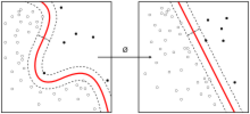Probably approximately correct learning
| Machine learning and data mining |
|---|
 |
In computational learning theory, probably approximately correct (PAC) learning is a framework for mathematical analysis of machine learning. It was proposed in 1984 by Leslie Valiant.[1]
In this framework, the learner receives samples and must select a generalization function (called the hypothesis) from a certain class of possible functions. The goal is that, with high probability (the "probably" part), the selected function will have low generalization error (the "approximately correct" part). The learner must be able to learn the concept given any arbitrary approximation ratio, probability of success, or distribution of the samples.
The model was later extended to treat noise (misclassified samples).
An important innovation of the PAC framework is the introduction of computational complexity theory concepts to machine learning. In particular, the learner is expected to find efficient functions (time and space requirements bounded to a polynomial of the example size), and the learner itself must implement an efficient procedure (requiring an example count bounded to a polynomial of the concept size, modified by the approximation and likelihood bounds).
Definitions and terminology
In order to give the definition for something that is PAC-learnable, we first have to introduce some terminology.[2]
For the following definitions, two examples will be used. The first is the problem of character recognition given an array of bits encoding a binary-valued image. The other example is the problem of finding an interval that will correctly classify points within the interval as positive and the points outside of the range as negative.
Let be a set called the instance space or the encoding of all the samples. In the character recognition problem, the instance space is . In the interval problem the instance space, , is the set of all bounded intervals in , where denotes the set of all real numbers.
A concept is a subset . One concept is the set of all patterns of bits in that encode a picture of the letter "P". An example concept from the second example is the set of open intervals, , each of which contains only the positive points. A concept class is a collection of concepts over . This could be the set of all subsets of the array of bits that are skeletonized 4-connected (width of the font is 1).
Let be a procedure that draws an example, , using a probability distribution and gives the correct label , that is 1 if and 0 otherwise.
Now, given , assume there is an algorithm and a polynomial in (and other relevant parameters of the class ) such that, given a sample of size drawn according to , then, with probability of at least , outputs a hypothesis that has an average error less than or equal to on with the same distribution . Further if the above statement for algorithm is true for every concept and for every distribution over , and for all then is (efficiently) PAC learnable (or distribution-free PAC learnable). We can also say that is a PAC learning algorithm for .
Equivalence
Under some regularity conditions these conditions are equivalent: [3]
- The concept class C is PAC learnable.
- The VC dimension of C is finite.
- C is a uniformly Glivenko-Cantelli class.[clarification needed]
- C is compressible in the sense of Littlestone and Warmuth
See also
References
- ↑ L. Valiant. A theory of the learnable. Communications of the ACM, 27, 1984.
- ↑ Kearns and Vazirani, pg. 1-12,
- ↑ Blumer, Anselm; Ehrenfeucht, Andrzej; David, Haussler; Manfred, Warmuth (October 1989). "Learnability and the Vapnik-Chervonenkis Dimension". Journal of the Association for Computing Machinery 36 (4): 929–965. doi:10.1145/76359.76371.
Further reading
- M. Kearns, U. Vazirani. An Introduction to Computational Learning Theory. MIT Press, 1994. A textbook.
- M. Mohri, A. Rostamizadeh, and A. Talwalkar. Foundations of Machine Learning. MIT Press, 2018. Chapter 2 contains a detailed treatment of PAC-learnability. Readable through open access from the publisher.
- D. Haussler. Overview of the Probably Approximately Correct (PAC) Learning Framework. An introduction to the topic.
- L. Valiant. Probably Approximately Correct. Basic Books, 2013. In which Valiant argues that PAC learning describes how organisms evolve and learn.
- "Relating Data Compression and Learnability". June 10, 1986. http://www.cse.ucsc.edu/~manfred/pubs/T1.pdf.
- Moran, Shay; Yehudayoff, Amir (2015). "Sample compression schemes for VC classes". arXiv:1503.06960 [cs.LG].
External links
 |
